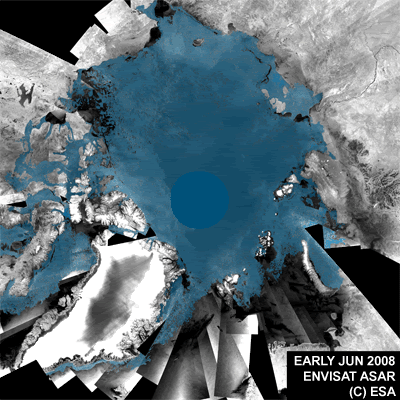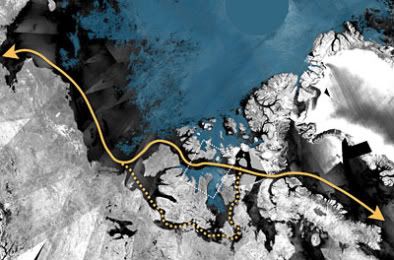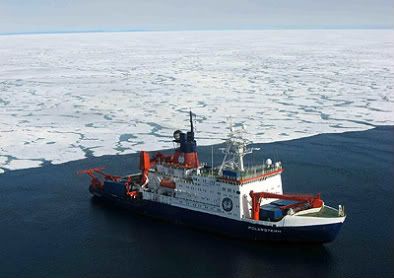ESA: Arctic ice on the verge of another all-time low

Envisat observations from mid-August depict that a new record of low sea-ice coverage could be reached in a matter of weeks. The animation above is a series of mosaics of the Arctic Ocean created from images acquired between early June and mid-August 2008 from the Advanced Synthetic Aperture Radar (ASAR) instrument aboard Envisat. The dark grey colour represents ice-free areas while blue represents areas covered with sea ice.
Current ice coverage in the Arctic has already reached the second absolute minimum since observations from space began 30 years ago. Because the extent of ice cover is usually at its lowest about mid-September, this year's minimum could still fall to set another record low.
Each year, the Arctic Ocean experiences the formation and then melting of vast amounts of ice that floats on the sea surface. An area of ice the size of Europe melts away every summer reaching a minimum in September. Since satellites began surveying the Arctic in 1978, there has been a regular decrease in the area covered by ice in summer – with ice cover shrinking to its lowest level on record and opening up the most direct route through the Northwest Passage in September 2007.


Our ice-breaking research vessel 'Polarstern' is currently on a scientific mission in the Arctic Ocean. Departing from Iceland, the route has taken the ship through the Northwest Passage into the Canadian Basin where geophysical and geological studies will be carried out along profiles into the Makarov Basin to study the tectonic history and submarine geology of the central Arctic Ocean. In addition, oceanographic as well as biological studies will be carried out. Polarstern will circumnavigate the whole Arctic Ocean and exit through the Northeast Passage. - Prof. Heinrich Miller, Alfred Wegener Institute (AWI), Bremerhaven, Germany
The polar regions, especially the Arctic, are very sensitive indicators of climate change, says Prof. Miller from AWI. The UN’s Intergovernmental Panel on Climate Change has shown that these regions are highly vulnerable to rising temperatures and predicted that the Arctic would be virtually ice-free in the summer months by 2070. Other scientists claim it could become ice-free as early as 2040. Latest satellite observations suggest that the Arctic could be mainly ice-free even earlier:
 energy :: sustainability :: biomass :: bioenergy :: renewables :: climate change :: arctic :: sea-ice :: Northwest Passage ::
energy :: sustainability :: biomass :: bioenergy :: renewables :: climate change :: arctic :: sea-ice :: Northwest Passage :: Scientists at AWI place particular emphasis on studying Arctic sea-ice, and along with in-situ studies of sea-ice thickness change satellite data have been used extensively - not only for the regular observation of changes in the Arctic and Antarctic, but also for optimising the operation of Polarstern in regions covered by sea ice.
The Arctic is one of the most inaccessible regions on Earth, so obtaining measurements of sea ice was difficult before the advent of satellites. For more than 20 years, ESA has been providing satellite data for the study of the cryosphere and hence revolutionising our understanding of the polar regions.
Satellite measurements from radar instruments can acquire images through clouds and also at night. This capability is especially important in areas prone to long periods of bad weather and extended darkness – conditions frequently encountered in the polar regions.
By making available a comprehensive dataset from its Earth Observation satellites and other ground and air-based capabilities, ESA is currently also contributing to one of the most ambitious coordinated science programme ever undertaken in the Arctic and Antarctic - the International Polar Year 2007-2008.
Further exploitation of data collected over the Arctic since 1991 is part of an ESA Initiative on Climate Change that will be proposed to the ESA Member States at its Ministerial Conference in November 2008. The proposal aims to ensure delivery of appropriate information on climate variables derived from satellites.
In 2009, ESA will make another significant contribution research into the cryosphere with the launch of CryoSat-2. The observations made over the three-year lifetime of the mission will provide conclusive evidence on the rates at which ice thickness and cover is diminishing.
Images courtesy of ESA.
References:
ESA: Arctic ice on the verge of another all-time low - August 28, 2008.
ESA: Envisat overview.
ESA: CryoSat 2.
International Polar Year.
Biopact: Satellites witness lowest Arctic ice coverage in history, Northwest Passage opens up - September 14, 2007
 --------------
--------------
 Mongabay, a leading resource for news and perspectives on environmental and conservation issues related to the tropics, has launched Tropical Conservation Science - a new, open access academic e-journal. It will cover a wide variety of scientific and social studies on tropical ecosystems, their biodiversity and the threats posed to them.
Mongabay, a leading resource for news and perspectives on environmental and conservation issues related to the tropics, has launched Tropical Conservation Science - a new, open access academic e-journal. It will cover a wide variety of scientific and social studies on tropical ecosystems, their biodiversity and the threats posed to them.









5 Comments:
Unfortunately for the point you are trying to make, current ice levels are already beginning to re-build in the Arctic. They never reached anything near to last year's decline, this year.
Instead of trying to force a round peg into a square hole--trying to force observations to fit models and expectations--it would be far better to keep an open mind to the universe as it actually is.
Dear aleese de finterhaben,
please write to ESA and tell them their satellite observations are wrong.
Good luck.
Jonas, perhaps you failed to read the actual script of the article. The arctic ice lows written about were projections, not observations. The projections were "supposedly" based upon observations, but could actually have been based upon someone paranoid's daydreams.
If you run a website, you need to differentiate between observations and projections, predictions, model runs, etc. There is a huge difference.
Fair enough, but please read along:
"Current ice coverage in the Arctic has already reached the second absolute minimum since observations from space began 30 years ago. Because the extent of ice cover is usually at its lowest about mid-September, this year's minimum could still fall to set another record low."
Could you please provide a link to the observations showing that sea ice cover is already beginning to rebuild, as you claim?
Thanks.
Jonas.
aleese: check this link for more accurate information on sea ice extent.
The problem for many people is that they do not understand how short a time 30 years is. In fact, sea ice has been lower than at present several times in the past 150 years.
Post a Comment
Links to this post:
Create a Link
<< Home